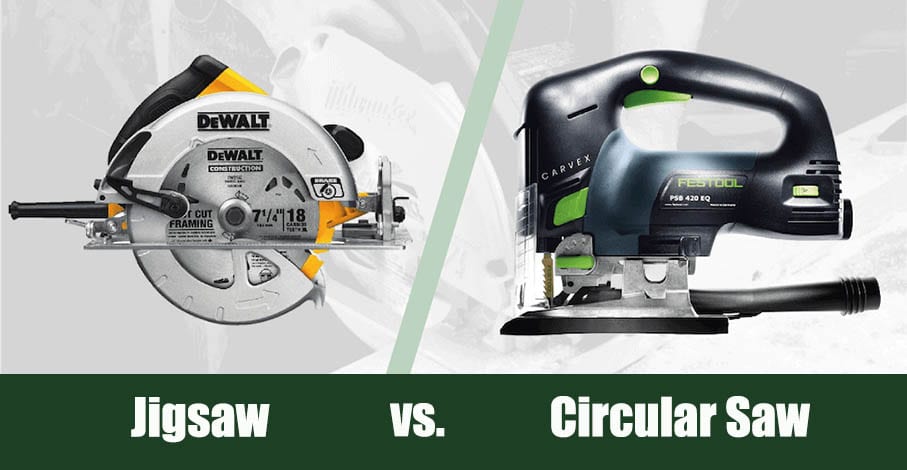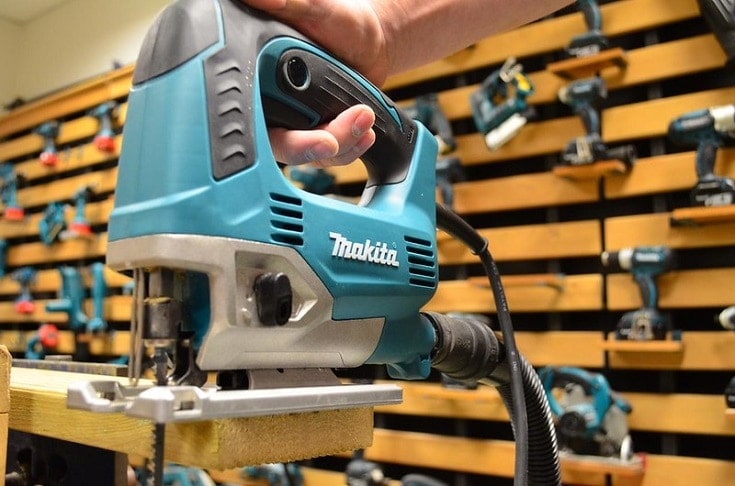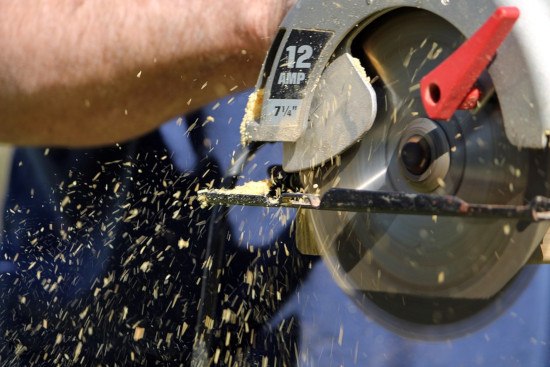Jigsaw vs Circular Saw: Which is Right for Your Needs?
-

- Last updated:


Suitable for far more than just cutting wood, both jigsaws and circular saws are versatile tools that anyone should be proud to have in their workshop.
But as any good woodworker knows, choosing the right tool for the job can make the difference between a clean and accurate finished product, or multiple frustrating failures.
That’s why we’ve put together this guide to the similarities and differences between jigsaws and circular saws. After covering the basics of each type of saw, we’ll give you a list of projects you might use them on as well as their pros and cons. Once you’re finished reading, you’ll know exactly which saw is best for your specific projects.
What is a Jigsaw?
Also known as a saber saw or scroll saw, the jigsaw is often advertised as a “do it all” saw for home improvement as well as arts and crafts projects. While this may be a bit too large of a claim for it, the jigsaw really is a fantastic tool for cutting irregular curves – something that many other saws struggle with.
Designed with a vertical blade embedded in a horizontal housing, jigsaws work via the action of a reciprocating blade. A metal shoe guides the blade, which is protected by a see-through blade guard to prevent accidental injury. Inside of the handle, you’ll find a trigger to activate the blade’s power, as well as an adjustable selector for blade speed.

Common Uses for Jigsaws
Able to be customized with a large selection of blades, jigsaws can be adapted to cut any sort of wood. Common ways of using a jigsaw include:
- Freehand sawing is useful for cuts that don’t require precision
- Cutting parallel to an edge can be accomplished with an adjustable side fence fitted
- Cutting along a temporary fence adds more accuracy to your cuts
- Making bevel cuts is done by adjusting the angle of your blade within the shoe
- Cutting an aperture inside of a board requires drilling a starter hole, then working slowly from the inside out
- Making sweeping curves can be done freehand, or with the aid of an attached compass
- Excellent for cutting curves
- Lightweight and easy to use
- Ideal for projects that require less precision
- Can make a very wide variety of cuts that other saws struggle with
- Less expensive than a circular saw
- Exceedingly difficult to use for accurate straight-line cuts
- Less expensive models tend to vibrate a lot
- Thin blades are prone to breakage
What is a Circular Saw?
The handheld counterpart of a table saw, circular saws are designed to do one thing incredibly well: Make precise, accurate, straight-line cuts. As the tool of choice for construction sites and contract home repairs, it’s an indispensable tool for cutting larger boards to size.

Common Uses for Circular Saws
Circular saws can be adapted to almost any purpose you can use a table saw for. Types of cuts that you can make with a circular saw include:
- Rip cuts
- Crosscuts
- Bevel cuts
- Miter cuts
- Freehand cuts
Also like a table saw, circular saws can be outfitted with different blades to make them more specialized to certain cuts. Uses for specific blades include:
- Pointed-tooth blades are suitable for crosscutting solid wood and leave a decent finish
- Fine-tooth blades cut relatively slowly, making them ideal for chipboard and plastic-laminated boards
- Rip blades are tipped with tungsten carbide, making them the best choice for ripping softwoods
- Chisel-tooth blades are suitable for ripping and crosscutting, making them a popular all-in-one blade choice
- Carbide-tipped universal blades are designed to leave a fine finish on every type of cut
- Greater power and faster blade speed than jigsaws
- Blades are durable and long-lasting
- Excellent for precise and accurate straight-line cuts
- A better choice for dense woods
- Heavier than a jigsaw
- Do not make curved cuts
- Requires more attention to safety precautions
- On the expensive side
- Loud
Which Saw is Right for You?
At this point, you have a much clearer idea of the similarities and differences between jigsaws and circular saws. This leads to the most important you’ll need to ask yourself in deciding between the two saws:
What sort of projects do you want to use your saw for?
Jigsaws are less precise but can make a wider variety of cuts than circular saws. This makes them ideal for use on projects where accuracy is not key – such as arts and crafts, some home improvement projects, and making decorative woodworking pieces. Their ability to cut broad, sweeping curves with ease is what most sets them apart from circular saws.
Meanwhile, circular saws have a high degree of precision combined with much greater cutting power. Often used instead of a dedicated table saw, they’re specifically designed to make highly accurate straight-line cuts. If you’re looking for a saw that can handle the rigors of a construction site or furniture-making, circular saws are preferable to jigsaws.
It’s worth mentioning that there’s no reason that you can’t have both types of saws – one for precision straight-line work, and the other for trickier curves and simple DIY projects. If it’s within your budget, the two saws can be used in tandem for even better woodworking results.
Final Thoughts
So, which saw do you think is the best for you? While both certainly have their advantages and disadvantages, they’re equally useful for certain types of jobs. Thank you for reading, and we hope you’ve discovered everything you hoped to know about the similarities and differences between jigsaws and circular saws!
- You might also like: Bosch JS260 Jigsaw Review – Pros, Cons, & Verdict
Contents

